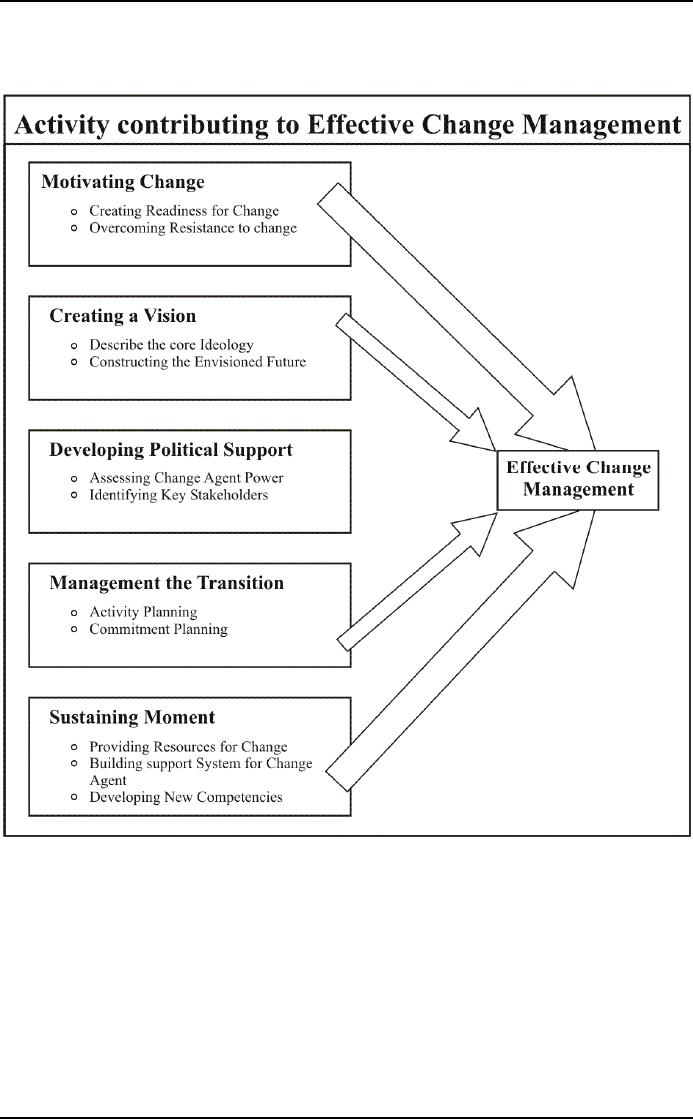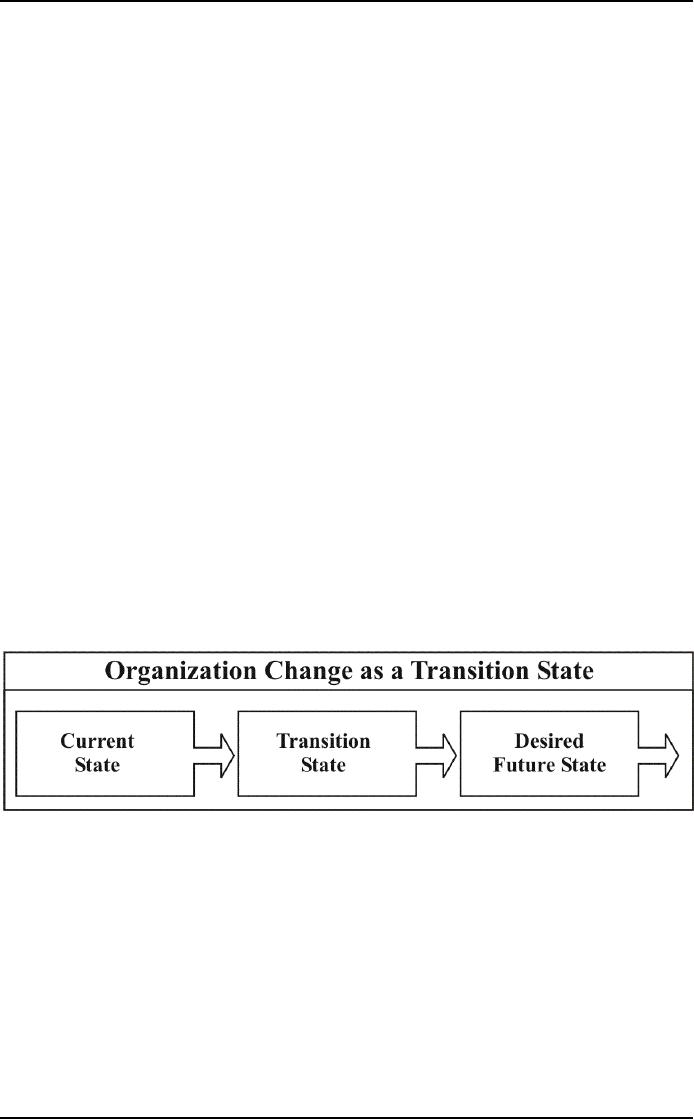 |

Organization
Development MGMT
628
VU
Lesson
24
Leading
and managing change
Figure
34: Activity Contributing to
Effective Change
Management
Creating
a Vision:
The
second activity in leading
and managing change involves
creating a vision of what members want
the
organization
to look like or become. It is
one of the most popular yet
least understood practices in
management.
Generally, a vision describe the
core values and purpose
that guide the organization as well
as
an
envisioned future toward which
change is directed. It provides a valued
direction for
designing,
implementing
and assessing organization changes.
The vision also can
energize commitment to change by
providing
members with a common goal
and a compelling rationale for why
change is necessary and
worth
the
effort. However, if the vision is
seen impossible or promotes
changes that the organization
cannot
implement,
it actually can depress
member motivation. For
example, George Bush's unfulfilled
"thousand
points
of light" vision was
emotionally appealing but it
was too vague and contained
little inherent
benefit.
In
contrast, John Kennedy's vision of
"putting a man on the moon
and returning him safely to
the earth"
was
just beyond engineering and technical
feasibility. In the context of the 1960s,
it was bold, alluring
and
vivid;
it provided not only a
purpose but a valued
direction as well. Recent research
suggests that

Organization
Development MGMT
628
VU
corporation
with carefully crafted vision
can significantly out perform the
stock market over long
periods
of
time.
Creating
a vision is considered a key
element in most leadership
frameworks. Organization or subunit
leaders
are responsible for
effectiveness, and they must
take an active role in
describing a desired future
and
energizing
commitment to it. In many cases,
leaders encourage participation in
developing the vision to
gain
wider input and support. For
example, they involve subordinates
and others who have a
stake in the
changes.
The popular media frequently
offer accounts of executives
who have helped to mobilize
and
direct
organizational change, including Nobuhiko
Kawamoto of Honda and Jack
Welch at General Electric.
Describing
a desired future is no less
important for people leading
change in small departments
and work
groups
than for senior executives.
At lower organizational levels, there
are ample opportunities to
involve
employees
directly in the visioning process.
Developing
a vision is heavily driven by people's
values and preference for
what the organization should
look
like and how it should
function. The envisioned future
represents people's ideals,
fantasies, or dreams
of
what they would like the organization to
look like or become.
Unfortunately, dreaming about the
future
is
discouraged in most organization, because
it requires creative and
intuitive thought processes
that tend to
conflict
with the rational, analytical methods
prevalent there. Consequently, leaders
may need to create
special
conditions in which to describe a
desired future such as off
site workshop or exercise
that stimulate
creative
thinking.
Research
by Collins and Porras
suggests that compelling visions
are composed of two parts:
(1) a relatively
stable
core ideology that describes
the organization's core values and
purpose, and (2) an envisioned
future
with
bold goals and a vivid
description of the desired future state
that reflects the specific
change under
consideration.
Describing
the Core
Ideology:
The
fundamental basis of a vision for
change is the organization's core
ideology. It describes the
organization's
core values and purpose
and is relatively stable over time.
Core values typically include
three
to
five basic principles or beliefs
that have stood the test of time
and best represent what the
organization
stands
for. Although the vision
ultimately describes a desired
future, it must acknowledge the
organization's
historical
roots, the intrinsically meaningful core
values and principles that
have guided and will guide
the
organization
over time. Core values are
not "espoused values"; they
are the "values in use" that
actually
inform
members what is important in the organization.
The retailer Nordstrom, for
example, has clear
values
around the importance of customer service; toymaker
Lego has distinct values around
the
importance
of families; and the Disney companies
have explicit values around
wholesomeness and
imagination.
These values define the true
nature of these firms and cannot be
separated from them.
Thus,
core
values are not determined or
designed; they are discovered
and described through a
process of inquiry.
Members
can spend considerable time
and energy discovering their
organization's core values through
long
discussion
about organizational history, key events,
founder's beliefs, and the work people
actually do, and
the
"glue" that holds the organization together. In
many cases, organizations want the
core values to be
something
they are not. For example,
many U.S firms want "teamwork" to be a
core value despite
strong
cultural
norms and organizational practices
that reward
individuality.
The
organization's core purpose is its
reason for being the idealistic
motivation that brings people to
work
each
day. A core purpose is not a
strategy. Purpose describes
why the organization exists; strategy
describes
how
an objective will be achieved. Organizations
often create a slogan or metaphor
that captures the
real
reason
they are in business. For
example, part of Disneyland's
return to prominence in the late 1980s
and
1990s
was guided by the essential purpose of
"creating a place where people
can feel like kids again".
Similarly,
Apple's original vision of "changing the
way people do their work"
describe well the benefits
the
organization
was providing to its
customers and society at
large. Many Apple employees
previously had
experienced
the drudgery of a boring job, an uninspired
boss, or an alienating workshop, and it
was alluring
to
be part of a company that
was changing work into
something more challenging,
creative or satisfying.
The
real power of an organization's core
ideology is its stability
over time and the way it can
help the
organization
change itself. Core values
and purpose provide
guidelines for the strategic
choices that will
work
and can be implemented versus
those that will not
work because they contradict the real
nature of the
organizations
identity. An envisioned future can be
compelling and emotionally powerful to
members only
if
it aligns with and supports
the organization's core values and
purpose.
Constructing
the Envisioned Future:
The
core ideology provides the context for
the envisioned future. Unlike core
values and purpose,
which
are
stable aspect of the organization and
must be discovered, the envisioned future
is specific to the change
project
at hand and must be created.
The envisioned future varies in
complexity and scope depending
on
the
changes being considered. A relatively
simple upgrading of a work group's word
processing software
requires
a less complex envisioned future than the
transformation of a government
bureaucracy.

Organization
Development MGMT
628
VU
The
envisioned future typically includes the
following elements that can
be communicated to organization
members:
1.
Bold
and valued outcomes. Descriptions of
envisioned futures often include specific
performance
and
human outcomes that the organization or
unit would like to achieve.
These valued outcomes
can
serve
as goals for the change
process and standards for
assessing program. For
example, BHAGs (Big,
Hairy,
and Audacious Goals) are
clear, tangible, energizing targets
that serve as rallying
points for
organization
action. They can challenge members to
meet clear target levels of
sales growth or
customer
satisfaction, to overcome key
competitors, to achieve role-model status in the
industry, or to
transform
the organization in some meaningful way.
For example, in 1990
Wal-Mart Stores made
a
statement
of intent "to become a $ 125
billion company by the year
2000" (Net sales in 1999
exceeded
$
137.6 billion). Following the downsizing
of the U.S. military budget, Rockwell
proposed the following
bold
outcomes for its change
efforts: "Transformation this company
from a defense contractor
into
the
best diversified
high-
technology
company in the world."
2.
Desired
future state. This
element of the envisioned future
specified, in vivid detail, what
the
organization
should look like to achieve
bold and valued outcomes. It
is a passionate and
engaging
statement
intended to draw organization members
into the future. The organizational
features describe
in
the statement help define a desired
future state toward which
change activities should move.
This
aspect
of the visioning process is exciting and
compelling. It seeks to create a
word
picture
that is
emotionally
powerful to members and
motivates them to change.
Developing
Political Support:
From
a political perspective, organizations
can be seen as loosely
structured coalitions of individuals
and
groups
having different preference and
interests. For example,
shop-floor workers may want
secure, high-
paying
jobs, and top executives
may be interested in diversifying the
organization into new business.
The
marketing
department might be interested in
developing new products and
markets, and the
production
department
may want to manufacture standard products
in the most efficient way.
These different
groups
or
coalitions compete with one another
for scarce resources and
influence. They act to preserve or
enhance
their
self-interest while managing to arrive at
a sufficient balance of power to sustain
commitment to the
organization
and achieve overall
effectiveness.
Given
this political view, attempts to
change the organization may threaten the
balance of power among
groups,
thus resulting in political conflicts and
struggles.
Individuals
and groups will be concerned
with how the changes affect
their own power and influence,
and
they
will act accordingly. Some
groups will become less
powerful; others will gain
influence. Those whose
power
is threatened by the change will
act defensively and seek to
preserve the status quo. For
example,
they
may try to act present
compelling evidence that change is
unnecessary or that only
minor modification
is
needed. On the other hand,
those participants who will
gain power from the changes
will push heavily
for
them, perhaps bringing in
seemingly impartial consultants to
legitimize the need for
change.
Consequently,
significant organizational changes are
frequently accompanied by conflicting
interest,
distorted
information, and political
turmoil.
Methods
for managing the political
dynamics of organizational change are
relatively recent additions to
OD.
Traditional, OD has neglected
political issues mainly because
its humanistic roots
promoted
collaboration
and power sharing among
individuals and groups.
Today, change agents are
paying increased
attention
to power and political activity,
particular as they engage in strategic
change involving most
parts
and
features of organizations. Some
practitioners are concerned, however, about whether
power and OD
are
compatible. A growing number of advocates
suggest that OD practitioners can
use power in positive
ways.
They can build their own
power base to gain access to
other power holders within the
organization.
Without
such access, those who
influence or make decisions may
not have the advantage of an
OD
perspective.
OD practitioners can use power strategies
that are open and aboveboard to
get those in power
to
consider OD applications. They can
facilitate processes for examining the
uses of power in organizations
and
help power holders devise
more creative and positive
strategies than political bargaining,
deceit, and the
like.
They can help power holders
confront the need for change
and can help ensure
that the interests
and
concerns
of those with less power are
considered. Although OD professionals
can use power
constructively
in organizations, they probably will
continue to be ambivalent and tense about
whether such
uses
promote OD values and ethics
or whether they represent the destructive,
negative side of power.
That
tension
seems healthy, and one can
hope that it will guide the
wise use of power in
OD.
Assessing
Change Agent
Power:
The
first task is to evaluate the
change agent's own sources
of power. This agent may be
the leader of the
organization
or department undergoing change, or he or she
may be the OD consultant if professional
help

Organization
Development MGMT
628
VU
is
being used. By assessing their
own power base, change
agents can determine how to
use it to influence
others
to support changes. They
also can identify areas in
which they need to enhance
their sources of
power.
Greiner
and Schein, in the first OD
book written entirely from a
power perspective, identified three
key
sources
of personal power in organizations (in
addition to one's formal
position): knowledge, personality,
and
others' support. Knowledge bases of power include
having expertise that is valued by
others and
controlling
important information. OD professional
typically gain power through
their expertise in
organizational
change. Personality sources of power
can derive from change
agents' charisma,
reputation,
and
professional credibility can
wield considerable power by providing
access to information and
resource
networks.
Others also may use their
power on behalf of the change agent. For
example, leaders in
organizational
units undergoing change can call on
their informal networks for
resources and support,
and
encourage
subordinates to exercise power in support of the
change.
Identifying
Key Stakeholders:
Having
assessed their own power
bases, change agents can
identify powerful individuals
and groups with an
interest
in the changes, such as staff groups,
unions, departmental managers, and
top-level executives.
These
key stakeholders can thwart
or support change, and it is important to
gain broad-based support
to
minimize
the risk that a single interest
group will block the
changes. Identifying key
stakeholders can
start
with
the simple question "Who stands to
gain or to lose from the
changes?" Once stakeholders
are
identified,
creating a map of their influence
may be useful. The map could
show relationships among the
stakeholders
in terms of who influences
whom and what the stakes are
for each party. This would
provide
change
agents with information about
which people and groups need
to be influenced to accept and
support
the changes.
Managing
the Transition:
Implementing
organizational change involves moving
from the existing organizational state to the
desired
future
state. Such movement does
not occur immediately but, as
shown in figure 35, instead
requires a
transition
state during which the organization
learns how to implement the conditions
needed to reach the
desired
future. Beckhard and Harris
pointed out that the
transition state may be
quite different from
the
present
state of the organization and
consequently may require special
management structures
and
activities.
They identified three major activities
and structures to facilitate organizational
transition: activity
planning,
commitment planning and change-management
structures.
Figure
35: Organization Change as a
Transition State
Activity
Planning:
This
involves the making a road map for change
citing specific activities and
events that must occur if
the
transition
is to be successful. Activity planning
should clearly identify, temporally
orient, and discrete
change
tasks and should link these
tasks to the organization's change goals
and priorities. Activity
planning
also
should gain top-management approval, be
cost effective, and remain
adaptable as feedback is
received
during
the change process.
An
important feature of activity
planning is that vision and
desired future states can be
quite general when
compared
with the realities of implementing
change. As a result it may be
necessary to supplement
those
with
midpoint goals as part of the
activity plan. Such goals
represent desirable organizational
conditions
between
the current state and the desired
future state. For example,
if the organization is implementing
continuous
improvement process, an important
midpoint goal can be the
establishment of a certain
number
of improvement teams focused on
understanding and controlling
key words process.
Midpoint
goals
are clearer and more
detailed than desired future
states, and thus they
provide more concrete
and
manageable
steps and benchmarks for
change. Activity plans can
use in midpoint goals to
provide members
with
the direction and security they
need to work towards the
desired future.

Organization
Development MGMT
628
VU
Commitment
Planning:
This
activity involves identifying
key people and groups whose
commitment is needed for change to
occur
and
formulating a strategy for gaining
their support. Although commitment
planning is generally a part
of
developing
political support, discussed above,
specific plans for
identifying key stakeholders
and obtaining
their
commitment to change need to be made
early in the change
process.
Change-Management
Structures:
Because
organizational transitions tend to be ambiguous
and to need direction,
special structures
for
managing
the change process need to be
created. These management
structures should include people
who
have
the power to mobilize resources to
promote change, the respect of the
existing skills to guide the
change
process. Alternative management
structures include the following:
·
The
chief executive or head person
manages the change
effort.
·
A
project manager temporarily is
assigned to coordinate the
transition.
·
The
formal organization manages the change
effort in addition to supervising
normal operations.
·
Representatives
of the major constituencies involved in the
change jointly manage the
project.
·
Natural
leaders who have the
confidence and trust of large
numbers of affected employees
are
selected
to manage the transition.
·
A
cross section of people representing
different organizational functions and
levels manages the
change.
·
A
"kitchen cabinet" representing people
whom the chief executive consults
with and confides in
manages
the change effort.
Sustaining
Momentum:
Once
organizational changes are under way,
explicit attention must be
directed to sustaining energy
and
commitment
for implementing them. The
initial excitement and
activity of changing often
dissipate in the
face
of practical problems of trying to
learn new ways of operating. A
strong tendency exists
among
organization
members to return to what is learned
and well known unless they
receive sustained
support
and
reinforcement for carrying the changes
through to completion. The
following five activities can
help to
sustain
momentum for carrying change
through to completion: providing
resources for change,
building a
support
system for change agents,
developing new competencies and
skills, reinforcing new
behaviors, and
staying
the course.
Providing
resources for
change:
Implementing
organization change generally requires
additional financial and
human resources, particularly
if
the organization continues day-to-day operations while
trying to change it. These
extra resources are
needed
for such change activities
as training, consultation, data
collection and feedback, and
special
meetings.
Extra resources also are
helpful to provide a buffer as
performance drops during the
transition
period.
Organizations can underestimate seriously
the need for special
resources devoted to the change
process.
Significant organizational change invariably
requires considerable management time
and energy, as
well
as the help of consultants. A separate
"change budget" that exists
along with capital and
operating
budgets
can earmark the resources
needed for training members
in how to behave differently
and for
assessing
progress and making necessary
modifications in the change program.
Unless these extra
resources
are
planned for and provided, meaningful
change is less likely to
occur.
Building
a support system for change
agents:
Organization
change can be difficult and
filled with tension, not
only for participants but
for change agents
as
well. They often must give
members emotional support, but they
may receive little support
themselves.
They
often must maintain "psychological
distance" from others to
gain the perspective needed to
lead the
change
process. This separation can produce
considerable tension and isolation, and
change agents may
need
to create their own support
system to help them cope
with such problems. A support
system typically
consist
of a network of people with whom the
change agent has close
personal relationships--- people
who
can
give emotional support, serve as a sounding
boards for ideas and
problems, and challenge
untested
assumptions.
For example, OD professionals
often use trusted colleagues
as "shadow consultants" to help
them
think through difficult
issues with clients and to
offer conceptual and
emotional support. Similarly, a
growing
number of companies, such as Intel,
Procter & Gamble, BHP-Copper, TRW,
and Texas
instruments,
are forming internal networks of
change agents to provide mutual learning
and support.

Organization
Development MGMT
628
VU
Developing
new competencies and skills:
Organizational
changes frequently demand
new knowledge, skills, and
behaviors from organization
members.
In many cases, the changes cannot be
implemented unless members gain
new competencies. For
example,
employee-involvement programs often require
managers to learn new
leadership styles and
new
approaches
to problem solving. Change agents
must ensure that such
learning occurs. They need to
provide
multiple
learning opportunities, such as
traditional training programs,
on-the-job counseling and
coaching,
and
experiential simulations, covering both
technical and social skills.
Because it is easy to overlook
the
social
component, change agents may
need to devote special time and
resources to helping members
gain
the
social skills needed to implement
changes. Ford's new CEO,
Jacques Nasser, is supporting
the
organization's
efforts to increase the speed of
decision making through a concerted
emphasis on
"teaching".
Through small-group discussions of
strategy, providing all
employees with a computer,
assignments
to develop new ideas, and
360-degree feedback. Ford
managers are learning new
skills and a
new
mindset to support the organization's need
for faster decision
making.
Reinforcing
new behaviors:
In
organizations, people generally do those
things that bring them rewards.
Consequently, one of the
most
effective
ways to sustain momentum for
change is to reinforce the kinds of behaviors
needed to implement
the
changes. This can be accomplished by
linking formal rewards directly to the
desired behaviors.
For
example,
Integra Financial encouraged more
teamwork by designing rewards and
recognition programs in
which
the best team players got
both financial rewards and
management attention, and a variety
of
behaviors
aimed at promoting self-interest
were directly discouraged. In
addition, desired behaviors
can be
reinforced
more frequently through
informal recognition, encouragement,
and praise. Perhaps
equally
important
are the intrinsic rewards
that people can experience
through early success in the
change effort.
Achieving
identifiable early successes
can make participants feel good about
themselves and their
behaviors,
and thus reinforce the drive to
change.
Staying
the course:
Change
requires time, and many of the
expected financial and organizational benefits
from change lag
behind
its implementation. If the organization changes
again too quickly or
abandons the change before it
is
fully implemented, the desired results
may never materialize. There
are two primary reasons
that
managers
do not keep a steady focus
on change implementation. First, many
managers fail to anticipate the
decline
in performance, productivity, or
satisfaction as change is implemented. Organization
members need
time
to practice, develop, and learn
new behaviors; they do not
abandon old ways of doing
things and
adopt
a new set of behaviors
overnight. Moreover, change
activities, such as training,
extra meetings, and
consulting
assistance, are extra
expenses added on to current operating
expenditures. There should be a
little
surprise, therefore, that effectiveness
declines before its get
better. However, perfectively good
change
projects
often are abandoned when
questions are raised about short term
performance decline.
Patience
and
trust in the diagnosis and intervention
design work are
necessary.
Second,
many managers don't keep
focused on a change because they want to
implement the next big
idea
that
comes along. When
organizations change before they have to
in response to the latest
management
fad,
a "flavor-of-the-month" cynicism can
develop. As a result, organization members
provide only token
support
to change under the (accurate) notion
that the current change won't
last. Successful organizational
change
requires persistent leadership
that doesn't waiver
unnecessarily.
OD
in Practice: Values drive
Culture and Operations at
Levi Strauss
Levi
Strass and Company, one of the world's
largest makers of blue jeans
and other apparel, has
been
engaged
in a culture change effort that
began in 1985. Following a
meeting with a small number of
minority
and
women managers who believed
there were invisible
barriers to advancement, the CEO, Robert
D.
Haas,
the great-great-grandnephew of founder
Levi Strauss organized an
off-site retreat that paired
white
senior
managers with minority and
women managers. The
two-and-one-half days of discussions
produced
painful
realizations about how the
firm treated its people.
What the small group had
identified was not so
much
a diversity problem as a leadership and
culture problem.
Today,
Levi Strauss is focused on
managing in a way that
balances concerns with a set
of values that honor
diversity,
empowerment, and openness.
The company has "struggled
mightily" to live up to a vision of
how
to
run a modern corporation a vision
set forth by Haas who
has demonstrated unswerving
commitment
to
it for more than ten years.
As part of a mission of "responsible
commercial success," the
following
Aspiration
Statement hangs on office
and factory walls throughout the
organization and guides all
major
decisions.
Aspiration
Statement
We
all want a company that our
people are proud of and committed to
where all employees have
an

Organization
Development MGMT
628
VU
opportunity
to contribute, learn, grow,
and advance based on merit,
not politics, or background. We want
our
people to feel respected, treated fairly,
listened to, and involved.
Above all, we want satisfaction
from
accomplishments
and friendships, balanced personal
and professional lives, and
to have fun in our
endeavors.
When
we describe the kind of Levi
Strauss and Company we want in the
future what we are talking
about
is
building on the foundation we have
inherited: affirming the best of
our Company's traditions,
closing
gaps
that may exist between
principles and practices, and
updating some of our values
to reflect
contemporary
circumstances.
What
type of Leadership is necessary to make
our aspirations a
reality?
New
Behaviors: Leadership that exemplifies
directness, openness to influence, commitment to the
success
of
others, and willingness to
acknowledge our own
contributions to problems, personal
accountability,
teamwork,
and trust. Not only must we
model these behaviors, but we
must coach others to adopt
them.
Diversity:
Leadership that values a
diverse workforce (age, ethnic group,
etc.) at all levels of
the
organization,
diversity in experience, and a diversity in
perspectives. We have committed to taking
full
advantage
of the rich backgrounds and abilities of
all our people and to promote a
greater diversity in
positions
of influence. Differing points of view
will be sought; diversity will be
valued and honestly
rewarded,
not suppressed.
Recognition:
Leadership that provides greater
recognition both financial and
psychic for individuals
and
teams
that contribute to our
success. Recognition must be given to all
who contribute: those who
create
band
innovate and those who
continually support day-to-day business
requirements.
Ethical
management practices: Leadership
that epitomizes the stated
standards of ethical behavior: We
must
provide clarity about our
expectations and must
enforce these standards
throughout the corporation.
Communications:
Leadership that is clear
about company, unit, and
individual goals and
performance.
People
must know what is expected of them
and receive timely, honest
feedback on their performance
and
career
aspirations.
Empowerment:
Leadership that increases the
authority and responsibility of those
closest to our products
and
customers. By actively pushing the
responsibility, trust, and recognition
into the organization, we can
harness
and release the capabilities of
all our people.
Haas
believes that successful corporations
are more than strategies and
structures. "This is where
values
come
in. In a more volatile and
dynamic business environment, the
controls have to be conceptual...
Values
provide a common language for aligning a
company's leadership and its
people" to the strategy. He
set
out to make each of his
workers, from the factory
floor on up, feel as if they are the integral
part of the
making
and selling of blue jeans.
All views on all issues
no matter how controversial
are encouraged,
heard,
and respected. The chairman
does not tolerate harassment of
any kind. Nor will he do
business with
suppliers
or customers who violate the
company' (Levi's) strict standards
regarding work environment
and
ethics.
For example, Levi's board voted
unanimously to pull its business
out of China in protest of human
rights
violations even though it
cost about $40 million of
revenues.
"We
are not doing this because
it makes us feel good although it
does. We are not doing this
because it is
politically
correct. We are doing this
because we believe in the interconnection
between liberating the
talents
of our people and business
success." However, the simple
truth is, living up to a
value system as
comprehensive
as Levi's is difficult. It takes hours
and hours of work by both
managers and organization
members.
To
implement this vision, Haas began at the
top. The first responsibility
for me and for my team
was to
examine
critically our own behaviors
and management styles in
relation to the behaviors and
values that we
profess
and to work to become more
consistent with the values
that we are articulating...You
can't be one
thing
and say another. People
have unerring direction
systems for fakes, and they
won't put up with
them.
They
won't put values into
practice if you're not." The
most difficult changes were
in behaviors that had
made
managers successful in the past.
Activities that were
productive under the old culture
were
counterproductive
in the flatter, more responsive,
and empowered organization that
top management was
trying
to implement.
To
push his vision into the
organization, Haas commissioned a set of
training courses, such as
leadership
week,
making ethical decisions, and
managing diversity. Specifically
designed not to be
"skill-building"
courses,
the sessions were more
likely highly experiential seminars.
During the sessions, managers
and
employees
grappled with their own
prejudices, attempted to make difficult
decisions using the
aspirations
statement
as a guide, and built a
support network that helped in applying
the ideas in the workplace. To
reinforce
the importance of the training, senior
management attended the courses,
came back to teach in
them,
and in some cases, went
through the courses again as participants
to gain additional insights
and
ideas.
In
addition, aspirations management
was given some teeth by making it an
important part of the
performance
management system. It includes a
360-degree-like feedback process;
each manager develops

Organization
Development MGMT
628
VU
an
"aspirational objective"; and
one-third of an employee's evaluation is
based on "aspirational"
behavioral.
The
aspirations statement has
also affected the way work
is designed. A new team-based
organization and
incentive
pay system means that a
worker's appraisals and compensation
depend on other
workers.
Although
more aligned with the values
of the organization, the work design
produces difficult tests
for
management.
For example, when workers
think that someone is faking
sick days or lollygagging on a
sewing
machine, tempers flare. Employee ABC
says that if someone calls
attention to a worker's laziness,
the
worker will just "flip
him off." Supervisor D says
that "it gets tough
out there." She finds
herself
intervening
to prevent "big fights."
Says plant manager EF "Peer
pressure can be vicious and
brutal."
Empowerment
and teamwork can be alien,
uncomfortable concepts for
those in the manufacturing plant
who
have spent their working
lives taking orders.
After
ten years of work, Haas is a
long way from realizing his
vision. "We are only a few
steps along in our
journey,"
he agrees. "We are far
from perfect. We are far
from where we want to be.
But the goal is out
there,
and it's worth striving
for."
Table of Contents:
- The Challenge for Organizations:The Growth and Relevance of OD
- OD: A Unique Change Strategy:OD consultants utilize a behavioral science base
- What an “ideal” effective, healthy organization would look like?:
- The Evolution of OD:Laboratory Training, Likert Scale, Scoring and analysis,
- The Evolution of OD:Participative Management, Quality of Work Life, Strategic Change
- The Organization Culture:Adjustment to Cultural Norms, Psychological Contracts
- The Nature of Planned Change:Lewin’s Change Model, Case Example: British Airways
- Action Research Model:Termination of the OD Effort, Phases not Steps
- General Model of Planned Change:Entering and Contracting, Magnitude of Change
- The Organization Development Practitioner:External and Internal Practitioners
- Creating a Climate for Change:The Stabilizer Style, The Analyzer Style
- OD Practitioner Skills and Activities:Consultant’s Abilities, Marginality
- Professional Values:Professional Ethics, Ethical Dilemmas, Technical Ineptness
- Entering and Contracting:Clarifying the Organizational Issue, Selecting an OD Practitioner
- Diagnosing Organizations:The Process, The Performance Gap, The Interview Data
- Organization as Open Systems:Equifinality, Diagnosing Organizational Systems
- Diagnosing Organizations:Outputs, Alignment, Analysis
- Diagnosing Groups and Jobs:Design Components, Outputs
- Diagnosing Groups and Jobs:Design Components, Fits
- Collecting and Analyzing Diagnostic information:Methods for Collecting Data, Observations
- Collecting and Analyzing Diagnostic information:Sampling, The Analysis of Data
- Designing Interventions:Readiness for Change, Techno-structural Interventions
- Leading and Managing Change:Motivating Change, The Life Cycle of Resistance to Change
- Leading and managing change:Describing the Core Ideology, Commitment Planning
- Evaluating and Institutionalizing Organization Development Interventions:Measurement
- Evaluating and Institutionalizing Organization Development Interventions:Research Design
- Evaluating and Institutionalizing Organization Development Interventions
- Interpersonal and Group Process Approaches:Group Process
- Interpersonal and Group Process Approaches:Leadership and Authority, Group Interventions
- Interpersonal and Group Process Approaches:Third-Party Interventions
- Interpersonal and Group Process Approaches:Team Building, Team Building Process
- Interpersonal and Group Process Approaches:Team Management Styles
- Organization Process Approaches:Application Stages, Microcosm Groups
- Restructuring Organizations:Structural Design, Process-Based Structures
- Restructuring Organizations:Downsizing, Application Stages, Reengineering
- Employee Involvement:Parallel Structures, Multiple-level committees
- Employee Involvement:Quality Circles, Total Quality Management
- Work Design:The Engineering Approach, Individual Differences, Vertical Loading
- Performance Management:Goal Setting, Management by Objectives, Criticism of MBO
- Developing and Assisting Members:Career Stages, Career Planning, Job Pathing
- Developing and Assisting Members:Culture and Values, Employee Assistance Programs
- Organization and Environment Relationships:Environmental Dimensions, Administrative Responses
- Organization Transformation:Sharing the Vision, Three kinds of Interventions
- The Behavioral Approach:The Deep Assumptions Approach
- Seven Practices of Successful Organizations:Training, Sharing Information